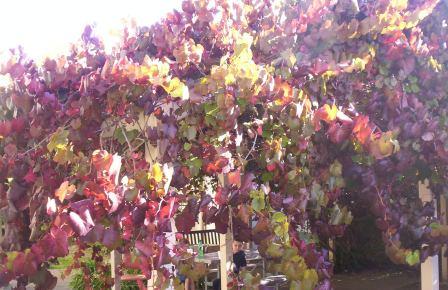|
Grapevine Pinot Gris Virus
''Grapevine Pinot gris virus'' (GPGV) is a positive sense single-stranded RNA virus in the genus ''Trichovirus''. It affects the growth of grapevine plants' leaves and fruit, and is similar to grapevine berry inner-necrosis virus. History Vineyards in northwest Italy began noticing symptoms of GPGV in 2003. The first two vineyards affected were Piana Rotaliana and Collio in Trentino Alto Adige. From there the virus spread to vineyards throughout Trentino Alto Adige and Friuli Venezia Giulia, then Emilia Romagna and Veneto. The virus was first identified on Pinot gris grapevines, hence the name, but soon spread to other varieties. In 2011, Annalisa Giampetruzzi et al. published an article in the journal ''Virus Research'' officially identifying and naming the virus.Giampetruzzi, Annalisa, et al. “A New Grapevine Virus Discovered by Deep Sequencing of Virus- and Viroid-Derived Small RNAs in Cv Pinot Gris”. ''Virus Research'', vol. 163, no. 1, 2012, pp. 262–268, doi:10.1016 ... [...More Info...] [...Related Items...] OR: [Wikipedia] [Google] [Baidu] |
Positive-sense Single-stranded RNA Virus
Positive-strand RNA viruses (+ssRNA viruses) are a group of related viruses that have positive-sense, single-stranded genomes made of ribonucleic acid. The positive-sense genome can act as messenger RNA (mRNA) and can be directly translated into viral proteins by the host cell's ribosomes. Positive-strand RNA viruses encode an RNA-dependent RNA polymerase (RdRp) which is used during replication of the genome to synthesize a negative-sense antigenome that is then used as a template to create a new positive-sense viral genome. Positive-strand RNA viruses are divided between the phyla ''Kitrinoviricota'', ''Lenarviricota'', and ''Pisuviricota'' (specifically classes ''Pisoniviricetes'' and '' Stelpavirictes'') all of which are in the kingdom '' Orthornavirae'' and realm '' Riboviria''. They are monophyletic and descended from a common RNA virus ancestor. In the Baltimore classification system, +ssRNA viruses belong to Group IV. Positive-sense RNA viruses include pathogens s ... [...More Info...] [...Related Items...] OR: [Wikipedia] [Google] [Baidu] |
Trichovirus
''Trichovirus'' is a genus of viruses in the order ''Tymovirales'', in the family ''Betaflexiviridae''. Plants, specifically angiosperms such as pome fruits, citrus, and pear, serve as natural hosts for this plant pathogen. There are seven species in this genus. Taxonomy The following species are assigned to the genus: *'' Apple chlorotic leaf spot virus'' *'' Apricot pseudo-chlorotic leaf spot virus'' *''Cherry mottle leaf virus'' *'' Grapevine berry inner necrosis virus'' *''Grapevine Pinot gris virus'' *''Peach mosaic virus ''Trichovirus'' is a genus of viruses in the order ''Tymovirales'', in the family '' Betaflexiviridae''. Plants, specifically angiosperms such as pome fruits, citrus, and pear, serve as natural hosts for this plant pathogen. There are seven spec ...'' *'' Phlomis mottle virus'' Structure Viruses in ''Trichovirus'' are non-enveloped, with flexuous and filamentous geometries. The diameter is around 10-12 nm, with a length of 640-760 nm. Geno ... [...More Info...] [...Related Items...] OR: [Wikipedia] [Google] [Baidu] |
Grapevine
''Vitis'' (grapevine) is a genus of 79 accepted species of vining plants in the flowering plant family Vitaceae. The genus is made up of species predominantly from the Northern Hemisphere. It is economically important as the source of grapes, both for direct consumption of the fruit and for fermentation to produce wine. The study and cultivation of grapevines is called viticulture. Most cultivated ''Vitis'' varieties are wind-pollinated with hermaphroditic flowers containing both male and female reproductive structures, while wild species are dieceous. These flowers are grouped in bunches called inflorescences. In many species, such as ''Vitis vinifera'', each successfully pollinated flower becomes a grape berry with the inflorescence turning into a cluster of grapes. While the flowers of the grapevines are usually very small, the berries are often large and brightly colored with sweet flavors that attract birds and other animals to disperse the seeds contained within the berrie ... [...More Info...] [...Related Items...] OR: [Wikipedia] [Google] [Baidu] |
Grapevine Berry Inner-necrosis Virus
''Vitis'' (grapevine) is a genus of 79 accepted species of vining plants in the flowering plant family Vitaceae. The genus is made up of species predominantly from the Northern Hemisphere. It is economically important as the source of grapes, both for direct consumption of the fruit and for fermentation to produce wine. The study and cultivation of grapevines is called viticulture. Most cultivated ''Vitis'' varieties are wind-pollinated with hermaphroditic flowers containing both male and female reproductive structures, while wild species are dieceous. These flowers are grouped in bunches called inflorescences. In many species, such as ''Vitis vinifera'', each successfully pollinated flower becomes a grape berry with the inflorescence turning into a cluster of grapes. While the flowers of the grapevines are usually very small, the berries are often large and brightly colored with sweet flavors that attract birds and other animals to disperse the seeds contained within the berri ... [...More Info...] [...Related Items...] OR: [Wikipedia] [Google] [Baidu] |
RefSeq
The Reference Sequence (RefSeq) database is an open access, annotated and curated collection of publicly available nucleotide sequences ( DNA, RNA) and their protein products. RefSeq was first introduced in 2000. This database is built by National Center for Biotechnology Information (NCBI), and, unlike GenBank, provides only a single record for each natural biological molecule (i.e. DNA, RNA or protein) for major organisms ranging from viruses to bacteria to eukaryotes. For each model organism, ''RefSeq'' aims to provide separate and linked records for the genomic DNA, the gene transcripts, and the proteins arising from those transcripts. ''RefSeq'' is limited to major organisms for which sufficient data are available (121,461 distinct "named" organisms as of July 2022), while GenBank includes sequences for any organism submitted (approximately 504,000 formally described species). RefSeq categories RefSeq collection comprises different data types, with different origins, so it i ... [...More Info...] [...Related Items...] OR: [Wikipedia] [Google] [Baidu] |
Apple Chlorotic Leafspot Virus
Apple chlorotic leafspot virus (ACLSV) is a plant pathogenic virus of the family '' Betaflexiviridae''. Damages This virus reduces tree vigor (50% on pear), reduces yield (40% on pear), and causes quality reduction on fruits (if symptomatic). Pathogen This virus is a trichovirus ''Trichovirus'' is a genus of viruses in the order ''Tymovirales'', in the family ''Betaflexiviridae''. Plants, specifically angiosperms such as pome fruits, citrus, and pear, serve as natural hosts for this plant pathogen. There are seven spe ... with filamentous particles. It has no natural vectors and it is easily transmitted mechanically to herbaceous hosts. Transmission The virus is only transmitted by grafting using infected clonal rootstocks, top-working existing trees with infected scion cultivars, and using infected trees as a source of propagation materials. External linksICTVdB – The Universal Virus Database: Apple chlorotic leafspot virus [...More Info...] [...Related Items...] OR: [Wikipedia] [Google] [Baidu] |
Cherry Mottle Leaf Virus
Cherry mottle leaf virus (CMLV) is a plant pathogenic virus causing leaf rot. It is closely related to the peach mosaic virus. Host and Symptoms Cherry mottle leaf virus (CMLV) has a wide range of hosts. It infects the genus Prunus including cherry (''Prunus avium'') and peach (''P. persica'') trees. More specifically, CMLV infects both sweet and bitter/wild type (''P. emarginata'') cherry trees.Reeves, E. L. (n.d.). MOTTLE LEAF, A VIRUS DISEASE OF CHERRIES ’. 18. UC IPM: UC Management Guidelines for Cherry Mottle Leaf on Cherry. (n.d.). Retrieved October 20, 2020, from http://ipm.ucanr.edu/PMG/r105102211.html#REFERENCE The most common propagation host is the ''Chenopodium quinoa''James, D., Jelkmann, W., & Upton, C. (1999). Specific Detection of Cherry Mottle Leaf Virus Using Digoxigenin-Labeled cDNA Probes and RT-PCR. Plant Disease, 83(3), 235–239. and the most common infected trees in the field are Bing and Napoleon trees. CMLV can be transmitted by budding and graftin ... [...More Info...] [...Related Items...] OR: [Wikipedia] [Google] [Baidu] |
Nucleotide
Nucleotides are organic molecules consisting of a nucleoside and a phosphate. They serve as monomeric units of the nucleic acid polymers – deoxyribonucleic acid (DNA) and ribonucleic acid (RNA), both of which are essential biomolecules within all life-forms on Earth. Nucleotides are obtained in the diet and are also synthesized from common nutrients by the liver. Nucleotides are composed of three subunit molecules: a nucleobase, a five-carbon sugar (ribose or deoxyribose), and a phosphate group consisting of one to three phosphates. The four nucleobases in DNA are guanine, adenine, cytosine and thymine; in RNA, uracil is used in place of thymine. Nucleotides also play a central role in metabolism at a fundamental, cellular level. They provide chemical energy—in the form of the nucleoside triphosphates, adenosine triphosphate (ATP), guanosine triphosphate (GTP), cytidine triphosphate (CTP) and uridine triphosphate (UTP)—throughout the cell for the many cellular func ... [...More Info...] [...Related Items...] OR: [Wikipedia] [Google] [Baidu] |
Enzyme
Enzymes () are proteins that act as biological catalysts by accelerating chemical reactions. The molecules upon which enzymes may act are called substrates, and the enzyme converts the substrates into different molecules known as products. Almost all metabolic processes in the cell need enzyme catalysis in order to occur at rates fast enough to sustain life. Metabolic pathways depend upon enzymes to catalyze individual steps. The study of enzymes is called ''enzymology'' and the field of pseudoenzyme analysis recognizes that during evolution, some enzymes have lost the ability to carry out biological catalysis, which is often reflected in their amino acid sequences and unusual 'pseudocatalytic' properties. Enzymes are known to catalyze more than 5,000 biochemical reaction types. Other biocatalysts are catalytic RNA molecules, called ribozymes. Enzymes' specificity comes from their unique three-dimensional structures. Like all catalysts, enzymes increase the reaction ra ... [...More Info...] [...Related Items...] OR: [Wikipedia] [Google] [Baidu] |
RNA-dependent RNA Polymerase
RNA-dependent RNA polymerase (RdRp) or RNA replicase is an enzyme that catalyzes the replication of RNA from an RNA template. Specifically, it catalyzes synthesis of the RNA strand complementary to a given RNA template. This is in contrast to typical DNA-dependent RNA polymerases, which all organisms use to catalyze the transcription of RNA from a DNA template. RdRp is an essential protein encoded in the genomes of most RNA-containing viruses with no DNA stage including SARS-CoV-2. Some eukaryotes also contain RdRps, which are involved in RNA interference and differ structurally from viral RdRps. History Viral RdRps were discovered in the early 1960s from studies on mengovirus and polio virus when it was observed that these viruses were not sensitive to actinomycin D, a drug that inhibits cellular DNA-directed RNA synthesis. This lack of sensitivity suggested that there is a virus-specific enzyme that could copy RNA from an RNA template and not from a DNA template. Distr ... [...More Info...] [...Related Items...] OR: [Wikipedia] [Google] [Baidu] |
Natural Reservoir
In infectious disease ecology and epidemiology, a natural reservoir, also known as a disease reservoir or a reservoir of infection, is the population of organisms or the specific environment in which an infectious pathogen naturally lives and reproduces, or upon which the pathogen primarily depends for its survival. A reservoir is usually a living host of a certain species, such as an animal or a plant, inside of which a pathogen survives, often (though not always) without causing disease for the reservoir itself. By some definitions a reservoir may also be an environment external to an organism, such as a volume of contaminated air or water. Because of the enormous variety of infectious microorganisms capable of causing disease, precise definitions for what constitutes a natural reservoir are numerous, various, and often conflicting. The reservoir concept applies only for pathogens capable of infecting more than one host population and only with respect to a defined target popula ... [...More Info...] [...Related Items...] OR: [Wikipedia] [Google] [Baidu] |






